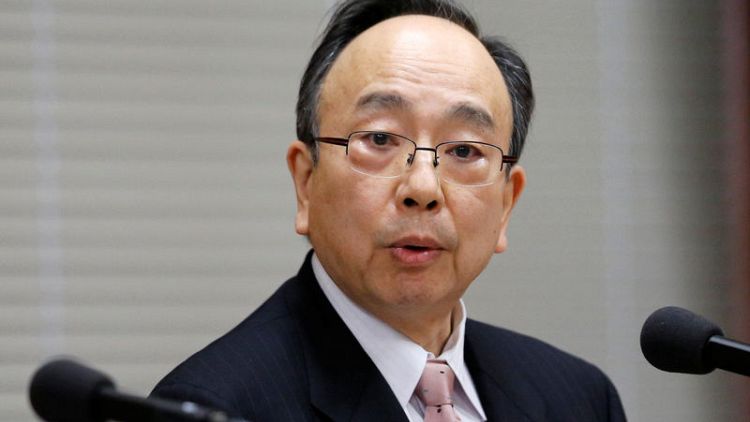By Leika Kihara
SHIMONOSEKI, Japan (Reuters) - The Bank of Japan can deploy various tools, or a combination of them, if it were necessary to expand stimulus, but would be mindful of the side effects of prolonged easing, the central bank's deputy governor Masayoshi Amamiya said on Thursday.
He reminded investors the BOJ would only consider topping up monetary support if the long-term path towards achieving the central bank's 2 percent inflation target was disrupted.
"As we mentioned when we deployed yield curve control in September 2016, we have various tools" if faced with the need to expand stimulus, Amamiya told a news conference after meeting business leaders in Shimonoseki, western Japan, on Thursday.
"It could be a single tool, a combination of them or an advanced version of them. We won't rule out various possibilities," said Amamiya, one of the BOJ's two deputy governors, as he sought to dispel speculation the central bank had run out of policy ammunition to fight the next recession.
The BOJ revamped its policy framework in September 2016 to one targeting interest rates from the pace of money printing. It now guides short-term interest rates at minus 0.1 percent and 10-year government bond yields around zero percent.
In making the tweak, the BOJ said its tool-kit for further easing included rate cuts and an increase in asset buying.
Amamiya said the BOJ would look through one-off factors that could weigh on inflation, such as planned cuts in mobile phone charges and education fees, and focus on the strength of the economy in judging whether it needs to ease more.
For now, the best way to hit the BOJ's inflation target was to support Japan's economy by maintaining its current ultra-loose policy for as long as necessary, he said.
"It will take time to change people's perception on prices formed during a prolonged period of low growth and deflation," said Amamiya, among the key architects of the BOJ's stimulus measures whose views are closely watched by markets.
"But we're in a situation where we also need to pay more attention to the accumulating side effects of monetary easing."
A BOARD DIVIDED
The BOJ is caught in a dilemma. Years of heavy money printing have failed to fire up inflation, forcing the BOJ to maintain its massive bond buying programme despite financial institutions having to endure weak profits from near-zero rates.
BOJ Governor Haruhiko Kuroda has said he will seek to hit the inflation target "step by step," but the nine-member board is divided between those who want stronger steps to achieve the target, and others who are worried about the rising cost of prolonged easing.
The rift was on full display at the BOJ's rate review in January, when one member called for the need to ramp up stimulus while another warned the central bank was nearing the limit on how much debt it could buy.
"The BOJ should stand ready to take policy action if risks to the economy and prices materialise," a board member said, according to a summary of opinions at the January meeting.
"When inflation is moving further away from our target, it's not a desirable approach to stand pat until a serious crisis occurs," said the board member, whose name was not identified in the summary released on Thursday.
Japan's annual core consumer inflation hit a seven-month low of 0.7 percent in December and may ease further in coming months due lower oil prices and soft household spending.
Adding to the BOJ's headaches, a slowdown in the world economy has jolted markets and led the International Monetary Fund to cut its global economic growth forecasts.
While the trend is for Japan's economy to continue expanding, Amamiya said risks to the outlook were heightening on China's slowdown and Sino-U.S. trade tensions.
"The effects of the trade tensions may spread, not only through the direct impact on trade, but through the damage on companies' investment appetite and the market's risk sentiment," he said in a speech to the business leaders in Shimonoseki.
(Additional reporting by Stanley White in Tokyo; Editing by Sam Holmes and Jacqueline Wong)



